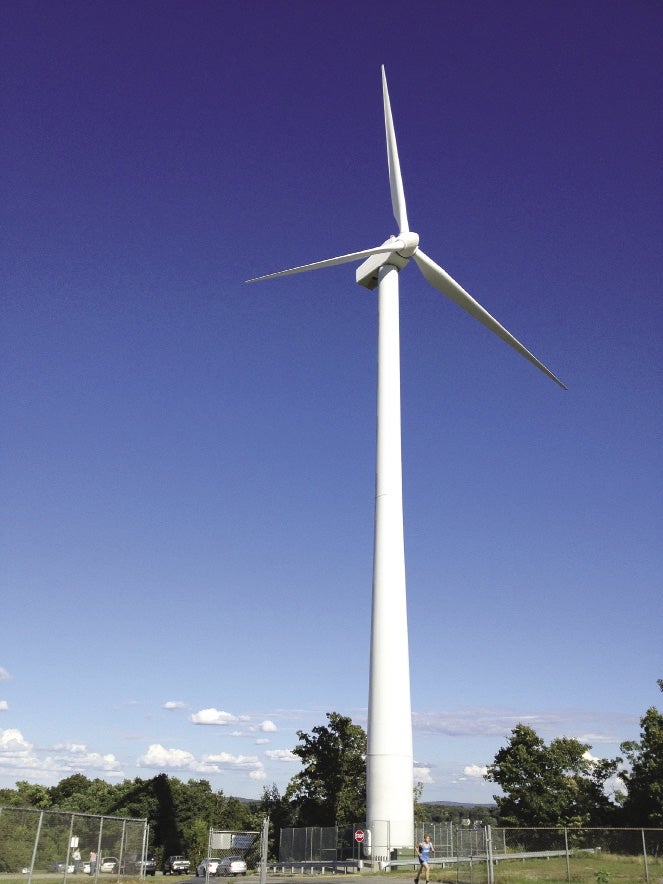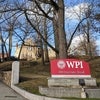Officials Hope New Technology Will Expand Wind Energy In Central Mass.
 PHOTO/JACQUELYN GUTC
A wind turbine at Holy Name Central Catholic Junior/Senior High School in Worcester, which was installed in 2008, provides the school with 90 percent of its energy, according to Headmaster Edward Reynolds.
PHOTO/JACQUELYN GUTC
A wind turbine at Holy Name Central Catholic Junior/Senior High School in Worcester, which was installed in 2008, provides the school with 90 percent of its energy, according to Headmaster Edward Reynolds.
The wind energy industry in Massachusetts is slowly and steadily growing, although it's not quite the darling that solar is. In Central Massachusetts, that may be even more true.
According to the Massachusetts Clean Energy Center (Mass CEC), there are more than 900 commercial solar projects in the state, versus 27 for wind.
However, as they work toward the Patrick administration's goal of generating 2,000 megawatts of wind power by 2020, state officials project that about 40 megawatts will be installed by the end of this year, bringing the total to 100. However, most of that is in Western Massachusetts.
"That does not, however, mean that there's no wind resources in Central Massachusetts; it's just a little more site specific," said Alicia Barton McDevitt, the center's president and CEO.
Six of the 27 commercial wind projects are in Central Massachusetts, with most of the others on the coast and in the Berkshires, where the wind is stronger.
"If you're going to make the big investment, you're going to want to put it someplace you want the turbines spinning the most, and that may not be Central Massachusetts," said Vincent DeVito, executive director of Worcester's Institute for Energy and Sustainability and an energy lawyer at Bowditch & Dewey.
State Cites CMass Successes
However, proponents of wind energy say the projects in Central Massachusetts are successful. Barton McDevitt said that, combined, they have 8.65 megawatts of installed capacity — enough to power more than 2,700 homes.
State Energy and Environmental Affairs Secretary Richard K. Sullivan said the two turbines installed on Mount Wachusett in January 2010 are a leading example of those successes.
Commissioned by the Princeton Municipal Light Department, the two 1.5-MW turbines generate about 40 percent of the town's power.
Barton McDevitt and Sullivan expect more wind advances in the region as new technology that requires less wind to generate energy becomes available. According to the Princeton Municipal Light District, a minimum wind speed of 7 mph is needed for a typical turbine to produce energy. A map produced by the National Renewable Energy Laboratory shows that the average wind speed north and south of Worcester is about 15 mph, compared to 11 mph to the east and west.
Noise Factors
In addition to the geographical challenges, wind turbines also face obstacles that solar doesn't. There are arguments against wind turbines because of their noise, the vibration that can be felt on the ground as they turn, and the blades' danger to birds.
"I think that there is more (acceptance) in a community when you're talking about a solar facility versus when you're talking about wind power," Sullivan said.
But Barton McDevitt said cost, along with national and global factors, pose the biggest challenges for industry growth.
And DeVito noted that the estimated cost of $1 million to $3 million for a turbine is a deterrent to construction, in part because of economic uncertainty. To help ease financial constraints, there's a federal renewable electricity production tax credit (PTC), and the MassCEC also issues loans and grants.
"It is a fact that, at the current point in time, renewable technologies — wind in particular — do rely on government support to spur their deployment and make them more competitive, economically," Barton McDevitt said. She added that uncertainty over whether the PTC will be renewed at the end of the year is a concern, and all the more important to the industry, as natural gas prices continue to plummet.
The complexity of wind projects is yet another obstacle. Barton McDevitt said that as more projects are installed, her organization learns how to make future endeavors go more smoothly, including supplying funding for feasibility studies.
"It's something that we have been doing and we've learned a lot along the way," she said.
Studies In Central Mass.
Auburn and Winchendon are conducting feasibility studies for their own projects.
But planning and implementation take years. Studying the possibility of wind energy since 2007, Auburn received an $85,000 grant from the MassCEC in 2010 to do a feasibility study of a 900-KW turbine. Last year, the town erected a wind test tower at Granger Cliffs on Prospect Hill.
Meanwhile, Winchendon landed a MassCEC grant for nearly $75,000 in 2010 for its own feasibility study, for a 600-KW to 2-MW turbine at Hillview Business Park.
Like the MassCEC, parties involved in all aspects of wind energy are learning with each project.
In December 2010, two 1.65-MW turbines were put up in Gardner at the North Central Correctional Institution (NCCI) that will also power the correctional center in Shirley. However, they have yet to be operational because National Grid had to upgrade its equipment. National Grid spokesman David Graves said the upgrades were necessary due to how much power the turbines will produce, as well as their distance from the substation.
"The turbines that were constructed at the jail … would produce about four times the amount of electricity that the jail would use during peak periods," he said. "That's quite a bit of energy coming into our distribution center."
Graves said the work required the buildout of power lines, transformers and other equipment that could handle the new energy.
In an email, Diane Wiffin, director of public affairs for the Massachusetts Department of Corrections (DOC), said the agency was scheduling a witness test, the final phase of the $10-million project, with National Grid for the end of September. Once they start working, the turbines are expected to save the state $1.3 million a year.
As far as wind energy in Central Massachusetts goes, the NCCI project looks promising and Sullivan said the city of Gardner is considering turbines as well.
Wiffin said the DOC chose wind over solar there because "data indicated that the area was one of the best wind source sites in the state. The (wind recording tower) that was on site for over a year prior to this project validated this data."
For wind energy proponents in the region, the Gardner site is one to be excited about.
Read more
State May Take Some Fire Out Of Biomass, Regulations Could Impact Fitchburg Plant
Mass Megawatts Losses Decrease
Solarize Mass. Adds 802 Projects, 5.1 MW To State
Upcycling Gives Gadgets Second Lives
Challenging 2012 For Wind-Energy Firms Filters Into Uncertain New Year









0 Comments